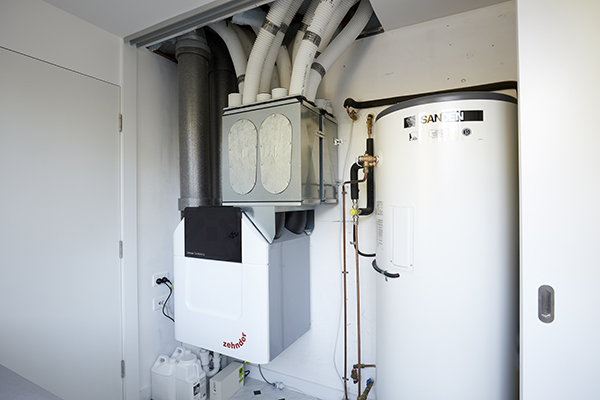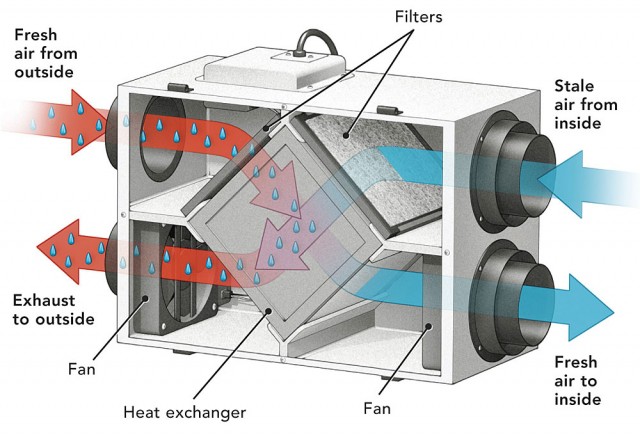Just How Heat Recovery Ventilation Improves Indoor Air Quality and Reduces Power Prices
Heat Recovery Ventilation (HRV) systems play an important function in boosting indoor air high quality while simultaneously lowering power expenses. By efficiently trading stagnant indoor air with fresh outside air, HRVs assist maintain optimal moisture and lower toxins. Additionally, their capability to recover warmth from outbound air minimizes the stress on heating and cooling systems. As energy costs continue to rise, understanding the complete potential of HRV systems ends up being progressively crucial for property owners and organizations alike.
Comprehending Heat Recovery Ventilation Solutions

Heat recovery ventilation (HRV) systems play an essential role in improving interior air top quality, specifically in modern, energy-efficient structures. These systems are created to transfer heat from the outward bound stagnant air to the incoming fresh air, thus reducing power loss while maintaining suitable temperature levels indoors. HRVs are composed of a heat exchanger, followers, and ductwork, facilitating the continual blood circulation of air. By eliminating interior toxins and introducing fresh air, HRVs aid to stabilize humidity levels, protect against mold growth, and minimize irritants. The efficiency of HRV systems lies in their ability to recuperate up to 80% of the warmth from the exhausted air, promoting energy conservation while making certain a healthy indoor setting. Their integration is crucial in achieving sustainable living practices.
The Importance of Indoor Air Quality
Indoor air quality (IAQ) is a vital variable influencing the health and well-being of occupants in any setting. Poor IAQ can bring about different health problems, including breathing troubles, allergic reactions, and exhaustion. Furthermore, it can aggravate status quo such as bronchial asthma. Factors adding to low IAQ consist of toxins from interior sources like cleansing agents, mold, and inadequate ventilation. Consequently, preserving excellent IAQ is crucial for promoting a safe and comfy living or working space. Efficient approaches to enhance IAQ include normal monitoring of air high quality, proper ventilation systems, and decreasing the use of harmful substances indoors. By prioritizing IAQ, individuals can ensure a much healthier environment that promotes performance and general top quality of life.
Power Performance Benefits of HRV Systems
Lots of homeowners and building managers are increasingly recognizing the energy effectiveness advantages of warmth recuperation ventilation (HRV) systems. By moving warmth from tired interior air to inbound fresh air, HRV systems significantly lower the power required for cooling and heating. This procedure reduces dependence on typical a/c systems, resulting in lower power bills. In addition, HRVs assist preserve a balanced interior climate, protecting against excessive heating or cooling down demands. The capacity to recoup up to 90% of the warmth from outward bound air likewise sustains sustainability initiatives by reducing general energy usage. HRV systems add not only to set you back financial savings however additionally to a decreased carbon footprint, aligning with the expanding focus on energy-efficient building practices.
Installment and Maintenance Considerations
The efficient execution of warmth healing ventilation (HRV) systems calls for cautious factor to consider of installment and maintenance elements to ensure peak efficiency. Correct positioning of the HRV device is essential, as it must be set up in a place that takes full advantage of airflow while decreasing sound disturbance. In addition, ductwork should be appropriately sized and protected to stop power loss. Regular maintenance, including filter substitute and system cleaning, is important to secure ideal capability and interior air quality. Owners need to establish a routine maintenance routine to identify and attend to potential issues prior to they intensify. Collaboration with seasoned specialists throughout both setup and upkeep stages can enhance the long life and efficiency of HRV systems, inevitably bring about far better indoor settings and minimized energy expenses.
Real-World Applications and Success Stories
Exploring real-world applications of heat recuperation air flow (HRV) systems reveals their considerable effect on indoor air high quality and power efficiency across numerous settings. click for more In property structures, property owners have actually reported better air top quality, leading to fewer allergic reactions and breathing concerns. Schools implementing HRV systems have kept in mind improved pupil concentration and reduced absenteeism as a result of far better ventilation. Industrial structures, such as offices and the original source retail spaces, have experienced reduced power costs and increased employee productivity. A corporate office in a temperate environment accomplished a 30% decrease in power expenses after setting up an HRV system. These success tales demonstrate that HRV innovation not only adds to much healthier atmospheres but additionally supplies substantial economic benefits, making it an important financial investment for various sectors.
Regularly Asked Inquiries
Can HRV Systems Reduce Irritants in Indoor Air?
The efficiency of HRV systems in decreasing interior allergens primarily rests on their capability to filter and exchange air. HRV Heat Recovery Ventilation. By continuously changing stale air, these systems can substantially lower irritant levels throughout interior environments

Just How Does Humidity Affect HRV System Efficiency?
Moisture greatly affects HRV system efficiency; high degrees can result in condensation, reducing effectiveness, while reduced humidity might enhance air exchange. Stabilizing humidity is vital for suitable procedure and preserving interior air high quality.
Are HRV Equipments Noisy Throughout Operation?
HRV systems can generate varying noise degrees during procedure, depending upon their design and installment. Some systems operate silently, while others may create obvious sound, particularly at higher air flow setups or when improperly maintained.
What Is the Typical Life-span of an HRV System?

Can HRV Equipments Be Used in All Environments?
HRV systems can be utilized in numerous environments, but their performance may differ - HRV Heat Recovery Ventilation. In extreme temperatures, modifications or supplemental systems may be necessary to guarantee ideal i was reading this efficiency and comfort while preserving interior air high quality